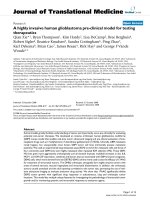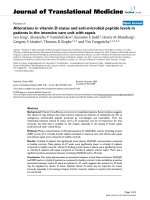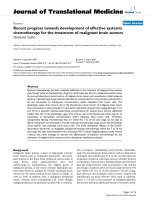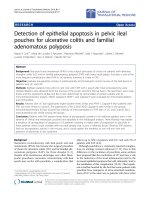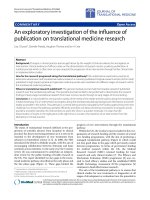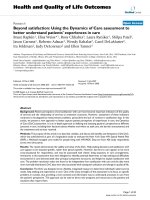báo cáo hóa học:" Extensor-tendons reconstruction using autogenous palmaris longus tendon grafting for rheumatoid arthritis patients" pot
Bạn đang xem bản rút gọn của tài liệu. Xem và tải ngay bản đầy đủ của tài liệu tại đây (501.62 KB, 5 trang )
BioMed Central
Page 1 of 5
(page number not for citation purposes)
Journal of Orthopaedic Surgery and
Research
Open Access
Research article
Extensor-tendons reconstruction using autogenous palmaris longus
tendon grafting for rheumatoid arthritis patients
Po-Jung Chu, Hung-Maan Lee, Yao-Tung Hou, Sheng-Tsai Hung, Jung-
Kuei Chen and Jui-Tien Shih*
Address: Department of Orthopaedic Surgery, Taoyuan Armed Forces General Hospital, 168, Jong-Shing Rd, Taoyuan County, Taiwan
Email: Po-Jung Chu - ; Hung-Maan Lee - ; Yao-
Tung Hou - ; Sheng-Tsai Hung - ; Jung-
Kuei Chen - ; Jui-Tien Shih* -
* Corresponding author
Abstract
Background: The purpose of the study is to retrospectively review the clinical outcome of our
study population of middle-aged RA patients who had suffered extensor-tendon rupture. We
reported the outcome of autogenous palmaris tendon grafting of multiple extensor tendons at
wrist level in 14 middle-aged rheumatoid patients.
Methods: Between Feb. 2000 to Feb. 2004, thirty-six ruptured wrist level extensor tendons were
reconstructed in fourteen rheumatoid patients (11 women and three men) using autogenous
palmaris longus tendon as a free interposition graft. In each case, the evaluation was based on both
subjective and objective criteria, including the range of MCP joint flexion after surgery, the
extension lag at the metacarpophalangeal joint before and after surgery, and the ability of the
patient to work.
Results and Discussion: The average of follow-up was 54.1 months (range, 40 to 72 months).
The average range of MCP joint flexion after reconstruction was 66°. The extension lag at the
metacarpophalangeal joint significantly improved from a preoperative mean of 38° (range, 25°–60°)
to a postoperative mean of 16° (range, 0°–30°). Subjectively all patients were satisfied with the
clinical results, and achieved a return to their level of ability before tendon rupture. We found good
functional results in our series of interposition grafting using palmaris longus to reconstruct
extensor tendon defects in the rheumatoid patients.
Conclusion: Reconstruction for multiple tendon ruptures is a salvage procedure that is often
associated with extensor lag and impairment of overall function. Early aggressive treatment of
extensor tendon reconstruction using autogenous palmaris longus tendon as a free interposition
graft in the rheumatoid wrist is another viable option to achieve good clinical functional result.
Published: 24 April 2008
Journal of Orthopaedic Surgery and Research 2008, 3:16 doi:10.1186/1749-799X-3-16
Received: 12 August 2007
Accepted: 24 April 2008
This article is available from: />© 2008 Chu et al; licensee BioMed Central Ltd.
This is an Open Access article distributed under the terms of the Creative Commons Attribution License ( />),
which permits unrestricted use, distribution, and reproduction in any medium, provided the original work is properly cited.
Journal of Orthopaedic Surgery and Research 2008, 3:16 />Page 2 of 5
(page number not for citation purposes)
Background
Wrist involvement is common for patients afflicted with
rheumatoid arthritis (RA), wrist level tendon rupture
commonly occurring in the extensor tendons of the ring
and small fingers. Once a tendon rupture at wrist level has
occurred, surgical techniques such as traditional end-to-
side tendon transfer (suturing the distal portion of the
ruptured tendon to an intact neighbouring tendon) or
tendon repair with end-to-end interposition grafting can
provide acceptable restoration of finger extensor function
subsequent to such procedures. The purpose of the study
is to retrospectively review the clinical outcome of our
study population of 14 middle-aged RA patients who had
suffered extensor-tendon rupture, and undergone tendon
reconstruction incorporating autogenous palmaris ten-
don grafting of the multiple extensor tendon(s) at wrist
level.
Patients and methods
Thirty-six ruptured extensor tendons derived from four-
teen RA patients (11 women and three men) were recon-
structed during the period Feb. 2000 to Feb. 2004
inclusively. (Table 1) The mean age of study participants
at time of surgery was 47.3 years (range, 32–66 years) and
their mean of time lag between tendon rupture and sur-
gery was 9.4 weeks. (range, 2 to 24 weeks) All of the
involved patients have received some level of medical
treatment for their arthritic condition. No patient had
undergone any previous surgical treatment to their hand.
Larsen's x-ray classification [1] was used to assess the rela-
tive severity of the rheumatoid arthritis from which each
study participant suffered. In each case, we reconstructed
extensor tendons using a section of autogenous palmaris
longus tendon as a free interpositional tendon graft. The
presence of this tendon was determined before grafting
procedure at our outpatient department. Fourteen consec-
utive patients were operated on by one surgeon (J.T.
Shih).
Surgical Procedure
A dorsal incision was made in the mid-line extending
from 5 cm proximally to 5 cm distally over the wrist, fol-
lowed by the raise of the skin flaps. For the next step, the
extensor retinaculum divided between the 5
th
and the 6
th
compartments, and reflected radially. Following this, the
extensor tendons were exposed, and the synovium over
the free ends of the tendons removed using a synovial
rongeur. A dorsal synovectomy of the wrist was then com-
pleted, and the dorsal bony surfaces inspected for any
bone spicules or abrasive irregularities that may have been
present, all of which were subsequently removed. Next,
the ruptured extensor tendons were identified, and mobi-
lized as was deemed to be necessary, and the tendon ends
were debrided and the defect in the length of the extensor
tendon was estimated.
Palmaris longus tendon was isolated by a transverse inci-
sion at wrist joint and then harvested using a tendon strip-
per or harvested through a number of small separate
flexor incisions. Appropriate lengths of palmaris longus
tendon were then used as free grafts to reconstitute the
ruptured extensor tendons. The distal end of the damaged
tendon was then secured by a series of six-strand sutures
method with 4-0 prolene which was placed through the
tendon graft and each of the ruptured tendon ends. (Fig.
1) Tensioning of the sutures was appropriately adjusted so
that the graft was snug with the wrist in a position of 40°
extension and with the metacarpophalangeal (MCP)
joints in a 15° of flexion. Following this weaving of the
proximal tendon stump was conducted using a Pulvertaft
Table 1: General Data of Patients
Case Gender Age Occupation Involved Wrist* Time lag(weeks) of tendon rupture
to surgery
Tendon rupture Advanced procedure
1 F 32 office lady (R) 6 EDC4/EDM
2 F 44 housewife (R) 13 EDC4/EDC5/EDM
3 F 46 nurse L 7 EDC4/EDC5/EDM Darrach procedure
4 F 52 baby-sitter L 14 EDC2/EDC3
5 M 40 soldier R 5 EDC3/EDC5
6 F 46 secretary L 2 EDC4/EDC5/EDM
7 F 54 housewife (R) 12 EDC4/EDC5/EDM
8 F 66 housewife (R) 24 EDC4/EDC5 Sauve-Kapandji procedure
9 F 38 dustmen L 8 EDC3/EDC4/EDM
10 F 42 secretary R 7 EDC2/EDC3/EDC4
11 M 53 factory worker (L) 12 EDC4/EDC5/EDM
12 F 56 dinner lady (R) 10 EDC4/EDC5/EDM Darrach procedure
13 F 46 hairdresser (R) 7 EDC5/EDM
14 M 47 machine
operatore
(R) 5 EDC4/EDC5
*Parentheses indicate that the injury involved the dominant limb; EDC: extensor digitorum communis; EDM: extensor digitorum minimi
Journal of Orthopaedic Surgery and Research 2008, 3:16 />Page 3 of 5
(page number not for citation purposes)
weave [2] secured with six-strand suture per anastomosis,
and the reconstructed tendons were passed under the ret-
inaculum. The repair was made in a position of 30° of
wrist extension with the expectation that the repair wound
stretch slightly as the wrist was exercised. Following this,
the surgical wound was then closed.
At the time of tendon reconstruction, synovectomy of the
distal radio-ulnar joint was also completed using a Dar-
rach procedure for two cases in which the distal ulna was
placed in a position of dorsal subluxation. Arthrodesis of
the DRUJ (Sauve-Kapandji procedure) was conducted for
one patient's wrist.
Post-operative Management
Postoperatively, the hand was immobilized in a splint,
with the wrist in 30 degrees of extension position in order
to relieve stress at the repair site, and to maintain the met-
acarpophalangeal and interphalangeal joints in a neutral
position. Passive interphalangeal-joint exercises were ini-
tiated 24–48 hours postoperatively and light active mobi-
lization of the metacarpophalangeal and the involved
wrist joint was commenced at two weeks post-surgery. The
use of dynamic extensor tendon splintage for early mobi-
lization of four weeks. Patients were weaned from the
splint over a period of three days. On removal of the
splint, active range of motion and tendon gliding exercises
were started.
The average of follow-up was 54.1 months (range, 40 to
72 months). The latest evaluation was based on both sub-
jective and objective criteria, including the range of MCP
joint flexion after surgery, the extension lag at the metacar-
pophalangeal joint before and after surgery, and the abil-
ity of the patient to work. The active range of motion of all
the study-participants' metacarpophalangeal joints flex-
ion were measured subsequent to surgery. In each case,
the extension lag, as determined at the metacarpophalan-
geal joint, was assessed both prior to and following ten-
don-repair surgery with a goniometer. Pearson's
correlation coefficient was used to assess the correlation
between the two quantitative variables. The ability to
work was evaluated on the basis of whether the patient
had returned to his or her original occupation and was
able to work full-time (100 percent) or part-time (25, 50,
or 75 percent of the normal time).
Results
Clinical Outcome
Fourteen rheumatoid-arthritis patients (36 tendon recon-
structions) were reviewed at an average of 54.1 months
post surgery (range, 40 – 72). The average range of MCP-
joint flexion subsequent to reconstruction was 66°. Fol-
lowing surgery, the extension lag at the metacarpophalan-
geal joint had been significantly improved from a
preoperative mean of 38° (range, 25°–60°) to a postop-
erative mean of 16° (range, 0°–30°) (p < 0.05). (Table 2)
(Fig. 2) We found good functional improvements for the
patients participating in our study, following interposi-
tional grafting using palmaris longus tendon in order to
reconstruct extensor tendon defects for the study-partici-
pating rheumatoid-arthritis patients.
Work status
Subjectively, all patients revealed that they were satisfied
with the clinical results of their surgical procedure, and all
had achieved a return to their previous occupations. One
patient returned to light work (75 percent of the preinjury
capacity) but had no difficulty with functions of daily liv-
ing and his avocation at the time of the 58-month follow-
up examination. Thirteen patients, however, continued
the same occupation at 100 percent of the preinjury
capacity including housekeeping.
Complication
There were no serious postoperative complications. No
patient lose MCP flexion due to the graft overtensionor
MCP joint extension contracture with average of follow-
up was 54.1 months (range, 40 to 72 months).
Discussion
The extensor tendons and soft-tissue envelope are fre-
quently compromised for RA patients. For patients suffer-
ing wrist level extensor tendon rupture associated with
rheumatoid arthritis (RA), primary tendon repair is gener-
ally not feasible. This relates to the diffuse nature of the ten-
don damage that typically occurs in such patients,
The extensor digitorum (ED) was reconstructed using free tendon grafting by means of a Pulvertaft techniqueFigure 1
The extensor digitorum (ED) was reconstructed
using free tendon grafting by means of a Pulvertaft
technique.
Journal of Orthopaedic Surgery and Research 2008, 3:16 />Page 4 of 5
(page number not for citation purposes)
combined with fibrosis, atrophy, and retraction of the mus-
cle, events that usually preclude effective tendon repair.
Several different methods have been previously used to
repair finger extensor-tendon ruptures at wrist level for the
rheumatoid-arthritis patient [3-8]. Primary repair involves
the end-to-end suture of the two ends of the damaged ten-
don, and, as best we are aware, is generally not feasible for
rheumatoid patients, as a significant length of tendon is
typically damaged by the mechanical attrition and inflam-
matory process that occurs following tendon rupture.
When multiple tendons are ruptured, the results of such
surgical repair by any of these techniques are often unsatis-
factory. The diffuse nature of the tendon damage, com-
bined with fibrosis, atrophy, and retraction of the muscle,
usually precludes repair. When rupture is diagnosed early,
tendon grafting may be successful [9]. Some authors think
that tendon grafting resulted in good correction of exten-
sion lag, but patients were dissatisfied with accompanying
loss of digital flexion because of the long standing nature of
the disease and decreased musculotendinous unit excur-
sion, leading to loss of flexion following grafting [10].
Good results have been reported for tendon grafts, pro-
vided that the time from tendon rupture to surgery is short
and muscle contracture is not allowed to become severe
[9,11,12].
Interpositional grafting is able to be used as a surgical-
repair technique for ruptured extensor tendons in order to
overcome the problem of defects in the extensor mecha-
nism where a portion of the relevant tendon has irreparably
damaged and effectively lost. The tendon graft can be
placed directly in between the ruptured extensor-tendon
ends, or alternatively, re-routed subcutaneously in order to
avoid the diseased tendon bed [5]. Interpositional tendon
grafting using palmaris longus to repair extensor-tendon
defects has previously been described as constituting a tech-
nique that can be effectively used for the repair of ruptured
finger-extensor tendons [13]. The palmaris longus is the
tendon of choice because it fulfils the requirements of
length, diameter, and availability without producing a
deformity. This choice of technique for tendon grafting fea-
tures the advantage of the source of donor tendon being
readily accessible in the same forearm.
The presence of this tendon should be determined before
any grafting procedure. The tendon is reported to be
present in one arm in 85% of people and in both arms in
70%. If the PL tendon absence occurred in our patients who
need autogenous tendon graft to reconstruction, long
extensors of toes were our second choice. The extensor of
the third toe is probably easiest to remove and use. The
Table 2: Functional Results of Patients
Case Extension Lag pre-op Extension Lag post-op Postoperative MCP joint flexion Ability to Work (Percent) F/U (mos)
128 9 85 100 51
245 25 66 100 53
353 28 55 100 47
429 13 73 100 41
530 18 78 100 69
645 20 65 100 68
760 24 40 100 44
850 30 65 100 40
935 15 57 100 46
10 25 5 53 100 66
11 42 16 63 75 58
12 36 18 60 100 72
13 27 8 76 100 42
14 25 0 85 100 60
MCP: metacarpalphalangeal
Photograph of the wrist made at the latest follow-up evalua-tionFigure 2
Photograph of the wrist made at the latest follow-up
evaluation. Reconstruction of a ruptured extensor tendon
conducted by means of free-tendon grafting. A, Extension
and B, Flexion.
Journal of Orthopaedic Surgery and Research 2008, 3:16 />Page 5 of 5
(page number not for citation purposes)
method is to make multiple short transverse incisions over
the tendon and remove it by elevating the skin proximal to
each incision and dissecting to a more proximal level; then
make another incision at this point and repeat the proce-
dure. Extract the divided end of the tendon through each
successive incision and remove it through the proximal
incision.
On the basis of the results of the study, good functional
outcomes can be achieved with end-to-end tendon-grafting
technique using autogenous palmaris longus tendon graft.
The mean extension lag of the metacarpophalangeal joint
following tendon grafting for our study participants was
16.4°, a figure which was somewhat better than the 30° fig-
ure reported in 1987 by Bora et al. [9]. Further, we observed
that metacarpophalangeal-joint flexion was improved for
all patients subsequent to surgery.
Promoting tendon healing and avoiding joint adhesion are
critical parts of the postoperative management of tendon
reconstruction following tendon rupture. In our study, the
Pulvertaft technique of weaving two tendons together was
used, it provides a very-strong connection between the two
grafted tendon ends, and a surgical repair technique that
can then be loaded more quickly. The feature of this tech-
nique makes the "early active" type of rehabilitative proto-
col (we allowed the wrists active flexion within one month
postoperatively in our series) feasible for patients having
undergone such a surgical-repair technique.
Dynamic splinting following extensor tendon repair is
becoming increasingly popular. The use of dynamic outrig-
ger splints which allow active flexion and extension of the
interphalangeal (IP) joints and active flexion but only pas-
sive extension of the MP joints. The dynamic splint com-
bined with the tendon mobilization program provided the
gliding necessary and was easy for the patient to comply
with and understand [14]. Some studies relating to "early
active" motion post surgical repair of ruptured extensor ten-
dons have shown that patients who undergo early control-
led, dynamic motion experienced improved damaged-
hand function more rapidly than was the case for those
more-immobilized patients, this shortening the overall
total rehabilitation time required post such injury, and
making dynamic motion treatment highly cost effective
[15].
Reconstruction for multiple tendon ruptures is a salvage
procedure that is often associated with extensor lag and
impairment of overall hand function. For our study, the
mean age at surgery for study participants was 47.3 (range,
32–66) years, the functional requirements of the injured
hands of the patients participating in our study being
highly "in demand" prospectively as regards these individ-
uals' working lives. The average range of MCP-joint flexion
and the extension lag at the metacarpophalangeal joint for
our study participants was shown to be improved signifi-
cantly following reconstruction using autogenous palmaris
longus tendon grafting.
Conclusion
In conclusion, multiple extensor-tendons reconstruction
using autogenous palmaris longus tendon grafting for
highly demand middle-aged rheumatoid arthritis patients
is another viable option in order to achieve good clinical
functional results post-operatively.
Competing interests
The authors declare that they have no competing interests.
Authors' contributions
PJC drafted the manuscript. PJC, HML and JTS participated
in the design of the study. All authors conceived of the
study, and participated in its design and coordination and
helped to draft the manuscript. All authors read and
approved the final manuscript.
References
1. Larsen A, Dale K, Eek M: Radiographic evaluation of rheuma-
toid arthritis and related conditions by standard reference
films. Acta Radiologica Diagnosis 1977, 18:481-91.
2. Pulvertaft RG: Tendon grafts for flexion tendon injuries in the
finger and thumb : a study of technique and results. J Bone Joint
Surg 1956, 38B:175-194.
3. Clayton ML: Surgical treatment at the wrist in rheumatoid
arthritis. J Bone Joint Surg [Am] 1965, 47:741-50.
4. Flatt AE: Care of the arthritic hand. St. Louis: The CV Mosby Co;
1983:110-30.
5. Nalebuff EA: Surgical treatment of tendon rupture in the
rheumatoid hand. Surg Clin North Am 1968, 49:811-22.
6. Nalebuff EA, Potter TA: Rheumatoid involvement of tendon
and tendon sheaths in the hand. Clin Orthop 1968, 59:147-59.
7. Vaughan-Jackson OJ: Rupture of extensor tendons by attribu-
tion at the inferior radio-ulnar joint. J Bone Joint Surg [Br] 1948,
30:528-30.
8. Moore JR, Weiland AJ, Valdata L: Tendon ruptures in the rheu-
matoid hand: Analysis of treatment and functional result in
60 patients. J Hand Surg [Am] 1987, 12A:9-14.
9. Bora FW, Osterman AL, Thomas VJ, Maitin EC, Polineni S: The
treatment of ruptures of multiple extensor tendons at wrist
level by a free tendon graft in the rheumatoid patient. J Hand
Surg [Am] 1987, 12A:1038-1040.
10. Nakamura S, Katsuki M: Tendon grafting for multiple extensor
tendon ruptures of fingers in rheumatoid hands. J Hand Surg
[Br] 2002, 27:326-8.
11. Minami M, Kato S, Yamazaki J, Minami A: Tendon ruptures in the
rheumatoid hand. In: Vastamäki M (Ed.) Current trends in
hand surgery. Amsterdam, Elsevier Science B V; 1995:515-521.
12. Mountney J, Blundell CM, McArthur P, Stanley D: Free tendon
interposition grafting for the repair of ruptured extensor
tendons in the rheumatoid hand.
J Hand Surg [Br] 1998,
23(5):662-665.
13. Mannerfelt LG: Tendon transfers in surgery of the rheumatoid
hand. Hand Clin 1988, 4(2):309-316.
14. Hung LK, Chan A, Chang J, Tsang A, Leung PC: Early controlled
active mobilization with dynamic splintage for extensor ten-
don injuries. J Hand Surg [Am] 1990, 15:251-7.
15. Germann G, Wagner H, Blome-Eberwein S, Karle B, Wittemann M:
Early dynamic motion versus postoperative immobilization
in patients with extensor indicis proprius transfer to restore
thumb extension: a prospective randomized study. J Hand
Surg [Am] 2001, 26:1111-5.
